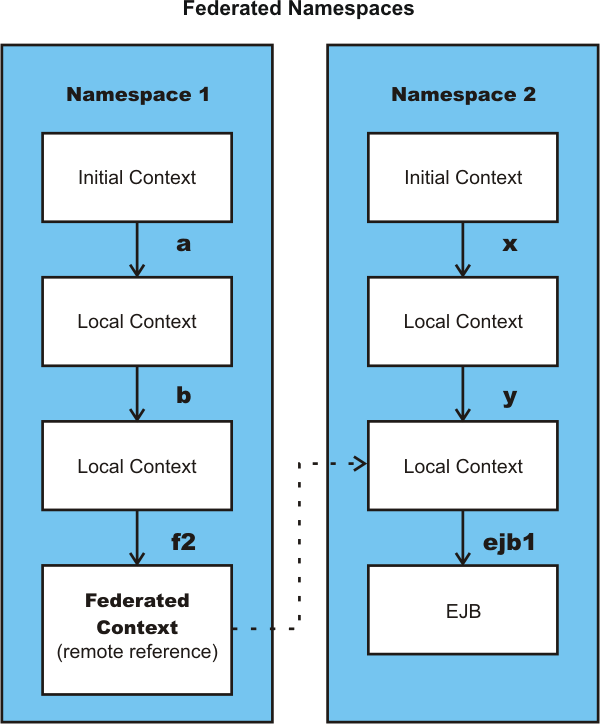Namespace federation
Federating namespaces involves binding contexts from one namespace into another namespace.
For example, assume that a namespace, Namespace 1, contains a context under the name a/b. Also assume that a second namespace, Namespace 2, contains a context under the name x/y. (See the following illustration.) If context x/y in Namespace 2 is bound into context a/b in Namespace 1 under the name f2, the two namespaces are federated. Binding f2 is a federated binding because the context associated with that binding comes from another namespace. From Namespace 1, a lookup of the name a/b/f2 returns the context bound under the name x/y in Namespace 2. Furthermore, if context x/y contains an enterprise bean (EJB) home bound under the name ejb1, the EJB home can be looked up from Namespace 1 with the lookup name a/b/f2/ejb1. Notice that the name crosses namespaces. This fact is transparent to the naming client.

In a product namespace, we can create federated bindings with the following restrictions:
- Federation is limited to CosNaming name servers. A product name server is a Common Object Request Broker (CORBA) CosNaming
implementation. We can create federated bindings to other CosNaming
contexts. We cannot, for example, bind contexts from an LDAP name server implementation.
- If we use JNDI to federate the namespace, use a WAS initial context factory to obtain the reference to the federated context. If we use some other initial context factory implementation, you might not be able to create the binding or the level of transparency might be reduced.
- A federated binding to a non-product naming context has the following functional limitations:
- JNDI operations are restricted to the use of CORBA objects. For example, we can look up EJB homes, but we cannot look up non-CORBA
objects such as data sources.
- JNDI caching is not supported for non-product namespaces. This restriction affects the performance of lookup operations only.
- If security is enabled, the producr does not support federated bindings to non-product namespaces.
- JNDI operations are restricted to the use of CORBA objects. For example, we can look up EJB homes, but we cannot look up non-CORBA
objects such as data sources.
- Do not federate two product stand-alone server namespaces. Incorrect
behavior might result. To federate product namespaces, use servers running under the WAS Network Deployment package of WAS.
- When federating the namespaces of two cells running a WAS Network Deployment package of WAS, the names of the cells must be different. Otherwise, incorrect behavior can result.
Related concepts
Related tasks